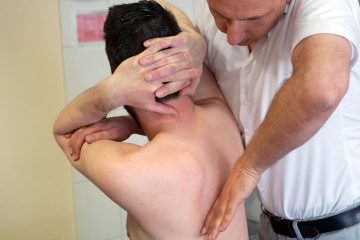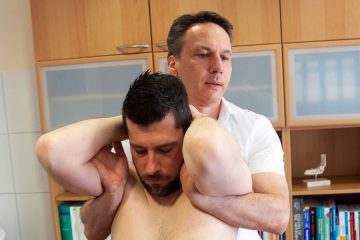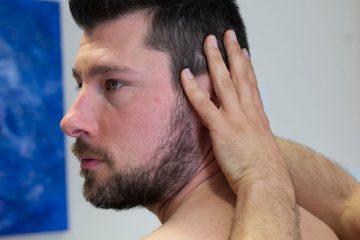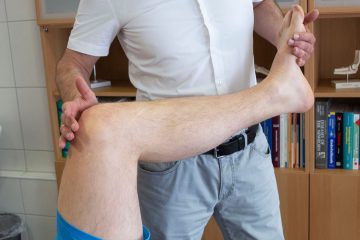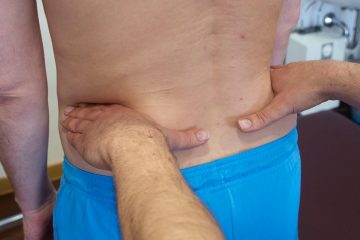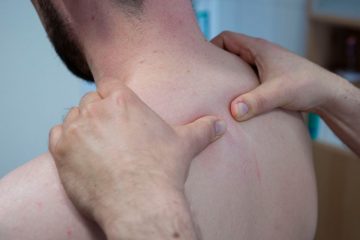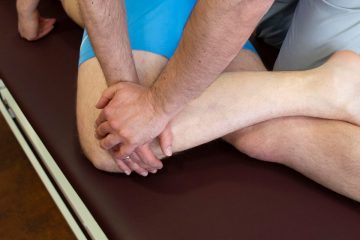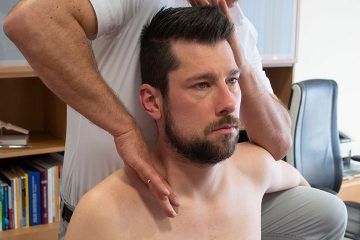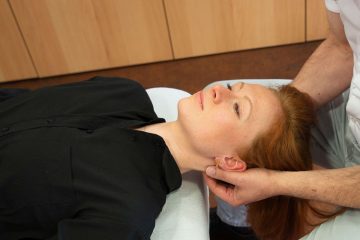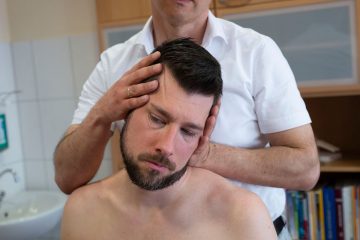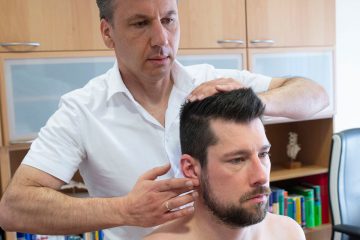If you have made an appointment for chiropractic treatment with us, please read the information sheet, print out and complete the questionnaire, and bring it with you to your appointment. The questionnaire can also be filled out in the practice immediately before the treatment.
Chiropractic/Manual Therapy
Chiropractic and manual therapy encompass the knowledge and treatment of functional and reversible diseases of the musculoskeletal system, including complications, using special manual examination and treatment techniques. The aim is to completely restore the mobility of the affected joint.
Who does not know this: back pain, stiff neck, joint problems, but also headaches, noises in the ears (tinnitus), dizziness, etc.
The patients usually describe it as follows: “I have a pinched nerve”, “I have lumbago”, “I am stiff from a draught”, “I lost my grip”, or “I slept in a terrible position”.
Many factors can trigger these problems. The well-known problems of lifting, poor posture when working, sitting for too long, as well as congenital or acquired malpositions of the musculoskeletal system.
The cause of the complaints are mostly blockages of the vertebral joints, vertebral-rib joints or the sacroiliac joint (SIJ). It is usually associated with one or more sections of the spine.
The symptoms: you feel tense and experience more or less severe pain which can radiate into the neck, trunk, arms and legs or even into the chest and head.
The most important task of the chiropractor is to examine whether the nerve function in the affected area of the body is disturbed. Above all, a herniated disc must be ruled out.
We work almost exclusively with so-called “soft techniques”, which are much gentler and informed by osteopathic therapeutic techniques.
Blockage
Blockage is a reversible segmental dysfunction of the spine (and other joints) that temporarily limits the mobility of a joint and increases muscle inflammation in that area.
Blockages can occur through everyday movements and can also spontaneously resolve. A cracking noise can occur, which is most likely caused by a negative pressure phenomenon when the joint cartilage adhesion is loosened in the joint space. If the blockage does not go away on its own, we can help with chiropractic techniques.
Therapy
Unblocking through targeted movements
The manipulation, the technique with impulse, with jerk or the “classic adjustment”. Here, blocked joints are released with targeted movements. The goal is to get the joint free again with as little force as possible: a short impulse, i.e. a quick, very short movement from what is known as a pretension. With these techniques a contraindication – a so-called “red flag” – must be ruled out under all circumstances. For this purpose, imaging is prescribed, especially in the area of the cervical vertebrae, as there is a risk of injury to nerves and blood vessels. Therefore, this technique should only be applied by a doctor trained in chiropractic therapy.
Mobilisation, the gentle technique without impulses.
In an effort to reduce risk, these techniques are generally preferable. Techniques without impulses are used here. If the diagnosis is correct and all “red flags” (contraindications) are excluded, the risk of injury is negligible.
Soft tissue techniques
Compression and stretching of muscles and tendons in the area of dysfunction in the back and the arms and legs.
Neuromuscular treatment
Conscious tensing and relaxing, with or without stretching, to correct functional disorders of muscles and joints.
With every manual therapeutic treatment, we work with the utmost care and in constant dialogue with the patient.
Osteopathy
An alternative form of medicine used to treat functional disorders. The osteopathic treatment is done exclusively with the hands. The osteopathic approach is holistic, taking a broader view of the entire body and context of the patient.
The three principles of osteopathy:
- the interactive unity of the individual body parts
- mutual dependencies of structure and function in the body (the structure determines the function and the function determines the structure)
- the self-healing mechanisms present in the body.
Osteopathic techniques
- myofascial release
- muscle energy technique (MET)
- atlas therapy
- craniosacral therapy
- counterstrain.
Atlas Therapy
Atlas therapy is a holistic treatment of the musculoskeletal system.
The atlas is the uppermost cervical vertebra. As the part of the spine that is closest to the skull, it carries the entire head. Hardly any other region of the body has as many nerves and nerve receptors as here. Sensitive structures such as the temporomandibular joint, the vestibular system and the inner ear are in the immediate vicinity.
In atlas therapy, a pressure is exerted with the finger on the lateral process of the atlas below the ear. It is a gentle technique. According to the theory, the stretching stimulus changes the muscular tension and the “perception pattern” of the receptors in the area of the atlas and represents a kind of “reset”.
